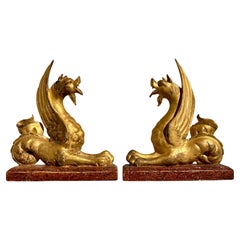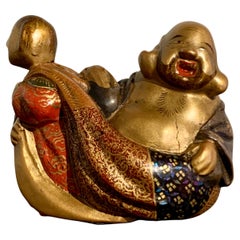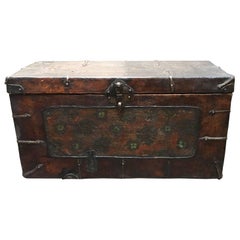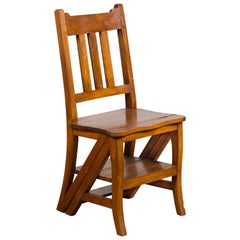Lotus Gallery More Furniture and Collectibles
19
to
19
19
19
19
1
1
8
8
3
2
1
1
1
9
7
6
6
4
17
13
6
5
3
Pair Italian Neoclassical Craved and Gilt Wood Mythical Beasts, mid 19th century
Located in Austin, TX
A powerful and dramatic pair of Italian neoclassical carved and gilt wood mythical animal figures on faux painted bases, mid 19th century or earlier, Italy.
The fantastic beasts are well carved, with dramatic wings that follow the sensuous curve of the neck, and a sinuous body ends in an eel-like tail gracefully curled in upon itself. The bearded heads feature a flattened snout with sharp teeth and a lolling tongue, and pointed horse ears and mane. The long forelegs stretched out in front of them and ending in pawed and clawed feet.
The beasts have characteristics of several different mythical animals, making them hard to positively identify. The most likely candidates would be dragons, hippocampi, or chimeras.
The beasts are unfinished to the back, indicating they were originally part of a relief decoration, possibly from a mirror. They have now been mounted to wooden bases faux painted to imitate porphyry.
They would make perfect bookends or mantle sculptures.
Category
Antique Mid-19th Century Italian Neoclassical Bookends
Materials
Gesso, Softwood, Giltwood
Chinese Ming Dynasty Sancai Glazed Pottery Architectural Model, 16th Century
Located in Austin, TX
An unusually large Chinese Ming Dynasty glazed pottery architectural model of a shrine or cabinet, Ming Dynasty (1368 - 1644), circa 16th century, China.
The shrine model crafted o...
Category
Antique 16th Century Chinese Ming Sculptures
Materials
Pottery
Japanese Silver Karabitsu Bonbonniere Box, Taisho Period, Japan
Located in Austin, TX
A fine Japanese silver bonbonniere box in the shape of a karabitsu, Meiji Period, circa 1900, Japan.
The small bonbonniere crafted of silver in the form of a karabitsu, a storage ...
Category
Vintage 1920s Japanese Meiji Metalwork
Materials
Silver, Sterling Silver
Boxwood and Lacquer Netsuke of Hotei by Shunsho, Meiji period, circa 1900, Japan
Located in Austin, TX
A charming and finely decorated carved and lacquered boxwood netsuke of Hotei by Shunsho (probably Shunsho XI, Masaoki), Meiji period, circa 1900, Japan.
This delightful and colorful netsuke features the beloved figure Hotei, one of the Seven Lucky Gods. The god of fortune and happiness is seated upon his treasure bag, and being dragged by a smiling child.
Carved from boxwood and decorated in bright lacquers of gold, silver, red, black and green. Hotei's chest and ample stomach mostly exposed, his skin covered in gold lacquer. Large elephantine ears frame his bearded face. His red-lipped mouth open in an uproarious laugh.
Hotei's treasure bag formed as a patchwork of various brocades in gold, red, and black lacquer. The black lacquer further decorated in the lac burgaute...
Category
Antique Early 1900s Japanese Meiji Sculptures and Carvings
Materials
Boxwood, Lacquer
Carved Boxwood and Lacquer Netsuke of a Noh Dancer, Meiji Period, Japan
Located in Austin, TX
A fine lacquer decorated carved boxwood netsuke of a Noh dancer in a Hannya role, unsigned, Meiji period, late 19th century, Japan.
The boxwood netsuke finely carved as a kneeling Noh dancer dressed in striking geometric patterned robes. The actor holds an opened war fan behind their back in one hand, a Shinto wand slung over the shoulder in the other.
The war fan, tessen, decorated in red lacquer with a golden rising sun at the center. Tessen were sturdy fans used by samurai as protective devices, and sometimes as weapons.
The wand, called an onusa, is a traditional Shinto ritual implement comprised of folded paper streamers, shide, attached to a wooden wand, often used in purification rituals. Here, the shide are crafted from silver maki-e, with the handle of the natural boxwood.
The actor wears a fierce and unearthly hannya mask...
Category
Antique 1890s Japanese Meiji Sculptures and Carvings
Materials
Boxwood, Lacquer
Tibetan Leather Painted Trunk
Located in Austin, TX
A charming Tibetan painted leather storage trunk, 18th century, Tibet.
Of smaller size, the softwood construction of the trunk covered by a richly tanned yak leather. The central p...
Category
Antique Late 18th Century Tibetan Tibetan Furniture
Materials
Wrought Iron
Chinese Dian Culture Large Gold Cuff, circa 2nd Century BC, Southern China
Located in Austin, TX
A large and impressive solid high karat gold cuff from the Dian Kingdom, circa 2nd century BC, modern day Yunnan Province, China.
.
This striking cuff is crafted from hand hammered ...
Category
Antique 15th Century and Earlier Chinese Han Antiquities
Materials
Gold
Large Nepalese Gilt Bronze Stupa, 16th/17th Century, Nepal
Located in Austin, TX
A spectacular large Nepalese stupa, of cast and repousse gilt bronze or copper alloy, 16th/17th century, Nepal.
The magnificent stupa of traditional form, featuring a stylized lotus base supporting a large dome. A square structure, called a harmika, sits upon the dome. Each side of the harmika featuring engraved Buddha Eyes, also called Wisdom Eyes. Torana rise above each of the four sides.
A tall spire, known as a yasti, rises from the squareharmika. Attached to the yasti are a set of thirteen graduated discs, known as chatras, giving the spire a tapered form. The chatras represent Bhumi, or the foundations that support the path to enlightenment.
The spire is topped by another stylized lotus platform with a rising square pillar topped...
Category
Antique 17th Century Nepalese Metalwork
Materials
Rock Crystal, Bronze, Copper
Burmese Kammavaca Giltwood Box, Stand, and Manuscript, 18th/19th Century
Located in Austin, TX
A gorgeous Burmese carved and gold leafed teakwood stand and cover for a kammavaca manuscript, late 18th or early 19th century, Burma.
The manuscript chest is heavily rococo influenced, speaking to the French presence in the region at the time. The carved teak stand is formed as a raised platform set upon four large scrolling acanthus leaf feet, with carved flour-de-lis to the apron.
The cover for the stand is also carved from teak, and features a series of rectangular cartouches, each set with a red foil backed glass "gem", surrounded by shell inlay, and embellished with green and silver foil backed glass sequins.
The top of the cover features the same design motif, with the addition of thayo lacquer design elements, and is strongly reminiscent of Tibetan manuscript...
Category
Antique Early 19th Century Burmese Rococo Lacquer
Materials
Gold Leaf, Foil, Silver Leaf
Japanese Lacquer Smoking Box, Tabako Bon, Edo Period, 19th Century
Located in Austin, TX
A very fine Japanese maki-e lacquer decorated tabako bon, or smoking box, late Edo Period, mid-19th century, Japan.
The elegant smoking box of black lacquer decorated with a wonderful gold lacquer takamaki-e design of a gnarled and elegantly twisted plum tree with branches in full bloom. A border of golden cranes in flight to the top.
The smoking box, called a tabako bon, is comprised of an open section at the top with inset with two cylindrical metal canisters...
Category
Antique Mid-19th Century Japanese Edo Lacquer
Materials
Lacquer
Nepalese Carved and Painted Buddhist Manuscript Cover, 15th Century
Located in Austin, TX
A fine and unusual wooden book or manuscript cover with a carved exterior and painted interior, 15th century, Nepal.
The exterior of the manuscript cover exuberantly carved with ...
Category
Antique 15th Century and Earlier Nepalese Tibetan Sculptures and Carvings
Materials
Wood
Khitan Liao Dynasty Gold Clad Horse Trappings, 10th-11th Century, China
Located in Austin, TX
A wonderful and rare set of Khitan Liao gold clad copper alloy repousse horse trappings, featuring thirteen pieces on a modern museum display mount, Liao Dynasty...
Category
Antique 15th Century and Earlier Chinese Tang Metalwork
Materials
Copper, Gold
Large Himalayan Inlaid Bronze Vajra with Wrathful Faces, 15th-16th Century
Located in Austin, TX
A large and unusual Himalayan bronze and mixed metal nine prong vajra featuring wrathful faces. In the style of the Tangut (Western Xia) Kingdom (1038 to 1227), but probably later, most likely 15th-16th century.
The body of the vajra crafted from a copper alloy, with five wrathful faces on either side and gold and silver inlays to the center. The prongs crafted of iron, with each side having eight prongs arcing outwards around a central prong before coming back to a copper alloy point.
The vajra is meditational tool...
Category
Antique 16th Century Mongolian Metalwork
Materials
Gold, Silver, Bronze, Iron
Roman Carved Marble Torso in Military Dress, circa 2nd-3rd Century
Located in Austin, TX
A well carved Roman marble figure of a male in military dress, late Roman Period, circa 2nd-3rd century.
The figure portrayed dressed in military att...
Category
Antique 15th Century and Earlier Italian Classical Roman Historical Memo...
Materials
Marble
Chinese Carved Zitan Table-Form Stand, Republic Period, Mid-20th Century
Located in Austin, TX
A finely carved zitan wood display stand in the form of a round table, China, Republic Period, mid 20th century.
The circular display stand carved from rare and precious zitan wood. Fashioned as a classical Chinese round table...
Category
Mid-20th Century Chinese Qing Scholar's Objects
Materials
Zitan
Large Japanese Black Lacquer Dowry Trunk, Nagamochi
Located in Austin, TX
Made for a member of the Japanese Imperial Family, as indicated by the sixteen petal chrysanthemum which appears in several elements of the relief carved shakudo and gold metal work on the trunk. The raised lacquer imperial chrysanthemum seal, of which only abstracted remnants remain, was probably intentionally abraded when this particular branch of the family was divested of its title during the American Occupation of 1947.
Of unusually generous proportions, with a slightly domed lid. Large handles on the side were used for carrying the the bridal trousseau. The hinges are constructed in such a way that the lid can be slid off after opening, for easier access.
Provenance: The estate of Ann Landers...
Category
Antique Late 19th Century Japanese Meiji Trunks and Luggage
Materials
Lacquer
Indian Glass Hookah Base
Located in Austin, TX
A finely crafted hookah base of thin, handblown glass. Elegant bell shape with a slightly everted neck. Etched floral and geometric motifs decorate the sid...
Category
Antique 19th Century Indian Tobacco Accessories
Materials
Blown Glass
Chinese Reverse Painted Glass and Hardwood Table Screen
Located in Austin, TX
An unusual table screen featuring a reverse glass painted portrait of a young noble lady set into a hardwood frame and stand.
The beautiful maiden has a roun...
Category
Antique Mid-19th Century Chinese Qing Paintings and Screens
Materials
Glass, Hardwood
Early 19th Century Chinese Hardwood, Lacquer and Jade Six-Panel Screen
Located in Austin, TX
A very fine mid-Qing Dynasty Chinese hardwood and lacquer six-panel screen, Jailing Period, circa 1800.
The hardwood frame inset with black lacquer panels. One side features an over...
Category
Antique Early 19th Century Chinese Qing Paintings and Screens
Materials
Coral, Jade
Related Items
Vintage Metamorphic Indian Wooden Step Ladder Folding Side Chair
Located in Yonkers, NY
A vintage Indian metamorphic wooden ladder chair from the mid-20th century. Created in India during the midcentury period, this convenient chair features a slanted slatted back flowi...
Category
Mid-20th Century Indian Ladders
Materials
Wood
Japanese Meiji Period Carved Wood Okimono Man with Rabbits
Located in Newark, England
The charming figure, carved from a single piece of wood is exceptionally carved showing the male figure with humorous expression holding two Rabbits one by the ears and the second under his arm. A third Rabbit stands at the feet of the male looking up, each rabbit with a different expression. The male figure is wearing traditional Japanese attire with his hair tied back stood upon a naturalistic base. The figure dates to the Meiji Period (1868-1912) circa 1900.
Notes The Rabbit is one of the 12 animals to feature in the Japanese Zodiac signs which follows the Chinese astrological system along with the Rat, Ox, Tiger, Rabbit, Dragon, Snake, Horse, Goat, Monkey, Rooster, Dog, Pig. Such division is connected with the Jupiter cycle around the Sun, which lasts about 12 years. As 2023 is the year of the Rabbit...
Category
Antique Early 1900s Japanese Meiji Sculptures and Carvings
Materials
Wood
Mahogany Architectural Model Staircase with Landing
Located in Bridgeport, CT
A well made solid wood eight step staircase with fine turned open sides and turned landing top supports, all with ball newel posts. With tall turned supports on the sides below the l...
Category
20th Century Georgian Architectural Models
Materials
Wood
Japanese Meiji Noh Mask in Carved Wood
Located in New York, NY
Japanese early Meiji period Noh theater mask made of carved wood with gofun layers. The piece was made in Japan in circa 1880 and is signed on the back. In great antique condition wi...
Category
Antique 1880s Japanese Meiji Sculptures and Carvings
Materials
Wood
Okitenugui Kabuto Samurai Helmet Shaped as a Head Towel Saika, Early Edo Period
Located in Milano, IT
Okitenugui kabuto
Samurai helmet shaped as a head towel
Saika, early Edo period, 17th century
The Haruta armorers who moved to Kii province in the early 17th century, took the name from the village where they worked, Saika, near Wakayama, possibly on request of the local daimyo, Asano Yukinaga, a great armour amateur. Specialised in the construction of plate helmets, they produced mainly two typologies of kabuto: one with six plates covered with a chrysanthemum-shaped plate on top and one shaped as a “head towel”, called okitenugui. The latter type of kabuto employs very heavy plates crafted in a curved manner and was improved in order to make it resistant to firearms.
This okitenugui kabuto features some distinctive decorations of the Haruta school, including the application of cut-out iron elements, including eyebrows, washers and lozenge-shaped decorations on the sides. The ring on the top, however, is a rare feature and could be used to hold a small war flag.
Category
Antique 17th Century Metalwork
Materials
Iron
Free Shipping
H 13.78 in W 15.75 in D 15.75 in
19th Century Italian Neoclassical Oil on Leather Three Panel Room Divider
Located in Forney, TX
A lovely 19th century Italian neoclassical oil on leather folding screen room divider.
Born in Italy, circa 1860, featuring patinated brass hinged three panel wooden frame wrapped in leather canvas hand painted with fantastical classical design depicting grotesque arabesque motif including putti cherub medzallions, floral wreaths, trailing foliage and ribbons on a pale olive green ground, accented by bronze stud tack trim sides and shaped top.
Dimensions: (approx)
73" High, 66.5" Wide, 1" Deep
Each panel: 22.25 Wide
Folded closed: 3" Deep
Detailed Condition Report:
In overall great antique condition. Beautifully aged distressed patina. Wear consistent with age and use, retaining original antique character...
Category
Antique 19th Century Italian Neoclassical Revival Screens and Room Dividers
Materials
Leather, Wood, Paint
19th Century Italian Leather Steamer Trunk
Located in Lambertville, NJ
A 19th century Italian leather trunk with metal studs decorating the exterior, original riveted hardware, linen interior, brass hinges. There are remnants of two decals from travel.
Category
Antique 1880s Italian Trunks and Luggage
Materials
Brass
Painted Swedish Trunk
Located in Wilson, NC
Painted Swedish trunk, the dome top with painted flowers and foliage, steel strap hinges and center steel handle. The front and sides have similar floral decoration.
Category
Antique 1850s Swedish Trunks and Luggage
Materials
Steel
Japanese Signed Hand Carved Wood Noh Theater Mask of Chujo, Early Showa Period
Located in Studio City, CA
A beautiful, wonderfully crafted, alluring mask made for Japanese Noh theatre.
The mask is handcrafted and hand-carved from natural wood and is signed by the maker, clearly a mast...
Category
Mid-20th Century Japanese Showa Masks
Materials
Wood, Paint
H 8.5 in W 5 in D 3 in
Vintage Triangular Hanukkah Menorah
Located in San Diego, CA
Beautiful vintage Hannukah Menorah. This vintage piece is a replica of a menorah from the 14th century southern Europe. Made in Israel, this piece is ...
Category
Vintage 1970s Israeli Baroque Metalwork
Materials
Brass
Italian Wooden Ship Model of a 15th/16th C. Galleon, Tall Ship, 3-Masat Schooner
Located in Atlanta, GA
An Italian wooden ship model of a 15th/16th century galleon, from the early to mid 20th century. This three-mast schooner model, when given a closer look, reveals the minutia in the details, from the beautifully carved stern and rudder, mermaid figurehead, cannon/gun-ports, the bow sprit, masts, flags, and dangling anchor. This tall ship model...
Category
Mid-20th Century Italian Architectural Models
Materials
Wood
H 29 in W 29 in D 8 in
Ebonized Chinoiserie Decorated Four Panel Landscape Screen with Garden, 20th C
Located in Big Flats, NY
An Asian style screen offers four Chinoiserie decorated ebonized panels with landscape scene having garden with tree, birds and pond, raised on square l...
Category
20th Century European Chinoiserie Screens and Room Dividers
Materials
Wood
H 72 in W 64 in D 1 in







